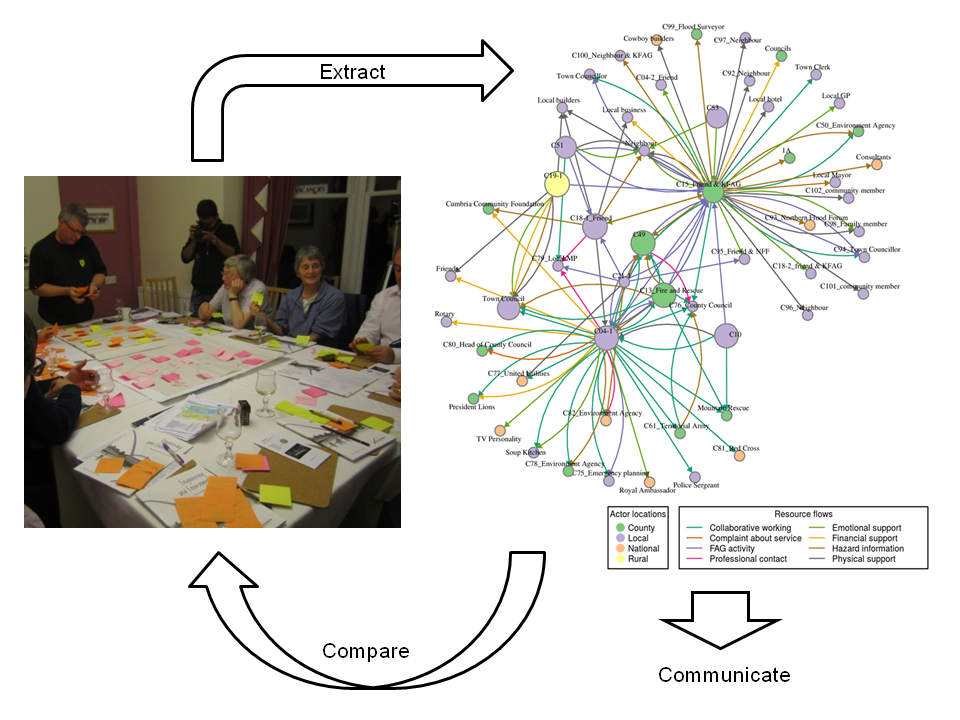Article /
Managing Complex Systems: The Need to Structure Qualitative Data

Summary
Scientific narratives of disasters are dominated by hydrologists, geologists, volcanologists, or other physical/natural sciences. Community resilience practitioners, however, may adopt more subjective narratives. Transdisciplinary approaches can help to recognise the complex nature of the social and physical/natural science issues involved.
This working paper* shows how ‘structured output’ methods can ‘abstract’ important issues and concepts and feed into planning and policy outputs. It discusses how different narratives can be used in structured methods (such as social network mapping; participatory modelling; and participatory mapping), retaining its veracity as qualitative data. Structured outputs can have immediate utility in a way that more ‘fuzzy’ qualitative outputs cannot: for example to ‘abstract’ important issues and concepts from the local to the more generic so that they may feed into planning and policy outputs; and translate important concepts across disciplinary and sectoral ‘silos’. Further, the structured outputs themselves may be used to allow stakeholders to ‘play’ with important ideas and what they mean to them and their communities.
This paper is organised into the following sections:
- Mapping of Social Networks as a Measure of Community Resilience
- Assessing Resilience Using Network Maps: The embrace Experience
- Agent‐Based Models (ABM)
- Two Case Studies of ABM in emBRACE
- Other Qualitative Data‐Structuring Methodologies
This working paper appears as a chapter in Framing Community Disaster Resilience: Resources, Capacities, Learning, and Action (2018).
*Download the full text from the right-hand column. A summary is provided below. See the full text for more detail. The final published text is available here.
Methods and Tools
In this method paper, we look at the development of suitable methodologies for integrating narrative data into research outputs. We report on the application of the methods to understand and map qualitative knowledge flows regarding communities’ responses to disasters.
Mapping of Social Networks as a Measure of Community Resilience
Social networks play a critical role in resilience to disasters. Social network maps (SNM) are a useful tool to help assess how the network structure – or pattern – is connected and how those individuals (nodes in the network) interact. Human social network follow identifiable and recognizable patterns: comparing any assessed network with an ideal network may also help researchers identify barriers or gaps among and between significant individuals. The purpose here in mapping the network using a structured methodology is to make overt the embodied characteristics and qualities that can contribute towards making any given community resilient.
Agent Based Models
Agent Based Models (ABMs) help explore the complexity of the situation where social and natural systems are coupled (intertwined) and where sub-systems need to be considered: the modelling process and model outputs can help to clarify and to communicate that complexity. Issues such as unpredictability, uncertainty, sensitivity to initial conditions, and interconnectedness can be included, as can possible future evolutions of the situation using simulations.
Lessons Learnt
Structured qualitative methods address the question of how localized interactions among social actors give rise to larger scale patterns or structures that may facilitate or constrain behaviour of actors.
- the output (map, network, model, game etc.) is apparently simple and interpretable by actors with a wide range of backgrounds
- simulation modelling may deliver a partial picture of resilient communities, systems and individuals, which appears most promising when ABM is included alongside other methods
- some of emBRACE’s key qualitative indicators are directly measurable using a SNM or SNA approach, or other structured subjective methods such as Q-methodology
Using structured subjective methods allow a better/wider appreciation of the range of qualitative and subjectively-held stakeholder’s positions. Outputs – if they retain truth and grounded nature in the local community – can allow significant community stakeholder buy in to research/governance processes, as well as better planning and policy outputs. Further, they facilitate the bringing together of ‘soft’ assessments of community – and often personal and inter-personal resilience – with ‘harder’ assessments of engineering methods.
The research can potentially be more useful and of greater benefit than when using science or practitioner narratives alone; structured outputs can have immediate utility in a way that more ‘fuzzy’ qualitative outputs cannot.
Suggested citation
Forrester, J. , Matin, N. , Taylor, R. , Pedoth, L. , Davis, B. and Deeming, H. (2018). Managing Complex Systems. In Framing Community Disaster Resilience (eds H. Deeming, M. Fordham, C. Kuhlicke, L. Pedoth, S. Schneiderbauer and C. Shreve). doi:10.1002/9781119166047.ch9
